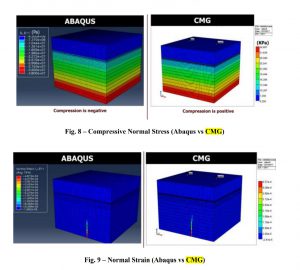COUPLED FLUID FLOW AND GEOMECHANICAL MODELING OF FAULT ACTIVATED INDUCED SEISMICITY
本文研究了油气行业中非常规页岩应用中储层流体流动与地质力学模拟的耦合。由于传统的储层模拟软件通常不支持孔隙压力变化和不同应力状态下的地质力学效应,因此需要将处理多相流和不同流体饱和度的有限差分流模拟器与包含地质力学能力的有限元分析软件应用相结合,但后者可能仅限于单相流体流动。本研究的目标是耦合流体流动与地质力学效应,使用商业有限元分析软件Abaqus和有限差分分析软件CMG来模拟孔隙压力、应力变化和应变变化,并进行比较。利用CMG和Abaqus耦合模型的储层材料属性和输出应变结果,计算了在具有潜在断层的储层系统中,不平衡废水注入和盐水生产期间诱发的地震矩。结果表明,流体流动和地质力学的结合对诱发地震性有影响。断层附近的应变变化更多地依赖于生产模式而非注入模式的变化,因为发生了压实。不平衡的目标储层注入-生产活动可能导致应变变化和地震性的增加。在研究的案例中,诱发地震性更与应变变化有关,而不是孔隙压力变化。
CMG软件应用情况:
CMG软件在本研究中被用于模拟流体流动和地质力学的耦合效应。通过CMG软件,研究者能够模拟多相流体流动和地质力学效应,并与Abaqus软件的结果进行比较。CMG软件采用有限差分方法,通过迭代耦合策略实现流体流动和地质力学之间的双向信息交换,直到模拟完成。
作者单位:
德克萨斯A&M大学(Texas A&M University),石油工程系
ABSTRACT
Many unconventional shale applications in the oil and gas industry require coupling of reservoir fluid flow with geomechanics simulations for a holistic study of formation stability. Since traditional reservoir simulation packages normally do not fully support geomechanical effects resulting from pore pressure change and varying stress states, finite difference flow simulators which handle multi-phase regimes with varying fluid saturation need to be supplemented with finite element analysis software applications that include geomechanics capabilities but might be limited to single phase fluid flow regimes. The general theme in events leading to induced seismicity from human interaction with the environment involves pore pressure, strain change, total stress and effective stress variations in a reservoir system with underlying faults, undergoing fluid injection and extraction. The objective of the current research study is to couple fluid flow with geomechanical effects to model pore pressure, stress variations and strain change using commercially available finite element analysis in Abaqus and finite difference analysis in CMG for comparison. Reservoir material properties and output strain results from both CMG and Abaqus coupled models are used to calculate induced seismic moments during unbalanced waste water injection and brine production in a reservoir system with an underlying fault. Results suggest that a combination of fluid flow and geomechanics can have an impact on induced seismicity. Near fault basement strain change depends more on production pattern compared to injection pattern variations as more compaction occurs. Unbalanced target formation injection-production activity can lead to increased strain change and seismicity in the basement. Induced seismicity is more related to strain change as opposed to pore pressure change for the cases studied here.


